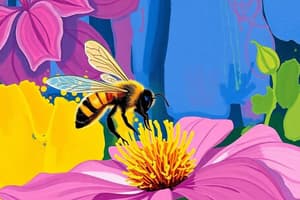Podcast
Questions and Answers
ما الدور الذي يلعبه الرائحة القوية في الزهور بالنسبة للحشرات؟
ما الدور الذي يلعبه الرائحة القوية في الزهور بالنسبة للحشرات؟
- تثير رد فعل في المناطق المجاورة
- جذب الحشرات لأخذ الطعام من الزهور
- تعمل كوسيلة لجذب الحشرات إلى الأوراق
- تحفيز الحشرات على نقل حبوب اللقاح (correct)
لماذا تكون الزهور المعدلة لتلقيحها بواسطة الرياح غالبًا بلا رائحة وغير ملفتة للانتباه؟
لماذا تكون الزهور المعدلة لتلقيحها بواسطة الرياح غالبًا بلا رائحة وغير ملفتة للانتباه؟
- لتكون أقل جاذبية للحشرات (correct)
- لتكون أكثر وضوحًا للعيون
- لتثير فضول الحيوانات
- لتجذب الحشرات
ما هي أحد الآثار المباشرة لفصل زهور النباتات العشبية مثل الماغنوليا إلى زهور ذكرية وأخرى أنثوية؟
ما هي أحد الآثار المباشرة لفصل زهور النباتات العشبية مثل الماغنوليا إلى زهور ذكرية وأخرى أنثوية؟
- زيادة مستوى التلقيح
- تقليل التنافس بين منتجي حبوب اللقاح (correct)
- القضاء على التلقيح
- زيادة المنافسة بين منتجي حبوب اللقاح
كيف يؤثر وجود زهور ذكرية وأنثوية على نباتات استوائية مثل الموز؟
كيف يؤثر وجود زهور ذكرية وأنثوية على نباتات استوائية مثل الموز؟
ما هي أحد الأسباب التي تدفع النباتات إلى استخدام عملية تخصيب ذاتي كالأتوغامية؟
ما هي أحد الأسباب التي تدفع النباتات إلى استخدام عملية تخصيب ذاتي كالأتوغامية؟
ما هو تأثير وجود زهور بتناظر ثنائي في النباتات على عملية التخصيب؟
ما هو تأثير وجود زهور بتناظر ثنائي في النباتات على عملية التخصيب؟
ما هي الوظيفة الرئيسية للأزهار في النباتات الزهرية؟
ما هي الوظيفة الرئيسية للأزهار في النباتات الزهرية؟
ما هي الأجزاء الرئيسية المكونة للزهرة؟
ما هي الأجزاء الرئيسية المكونة للزهرة؟
كيف تتم عملية التلقيح في بعض النباتات؟
كيف تتم عملية التلقيح في بعض النباتات؟
ما هو الجزء الذي يتطور إلى الثمرة في بعض النباتات؟
ما هو الجزء الذي يتطور إلى الثمرة في بعض النباتات؟
ما هي وظيفة حبوب اللقاح في عملية التكاثر الجنسي للنباتات الزهرية؟
ما هي وظيفة حبوب اللقاح في عملية التكاثر الجنسي للنباتات الزهرية؟
كيف تتكون البذور في النباتات العشبية؟
كيف تتكون البذور في النباتات العشبية؟
Flashcards
Angiosperms
Angiosperms
Flowering plants that produce seeds enclosed within a fruit.
Flowers
Flowers
The reproductive structure of flowering plants, which facilitates sexual reproduction.
Stamen
Stamen
The male reproductive organ of a flower, responsible for producing pollen.
Pistil
Pistil
Signup and view all the flashcards
Pollen grains
Pollen grains
Signup and view all the flashcards
Pollination
Pollination
Signup and view all the flashcards
Cross-pollination
Cross-pollination
Signup and view all the flashcards
Self-pollination
Self-pollination
Signup and view all the flashcards
Cleistogamy
Cleistogamy
Signup and view all the flashcards
Insect-pollinated flowers
Insect-pollinated flowers
Signup and view all the flashcards
Wind-pollinated flowers
Wind-pollinated flowers
Signup and view all the flashcards
Fruit development
Fruit development
Signup and view all the flashcards
Study Notes
Flowers are an essential part of plant reproduction in flowering plants. These plants, also known as angiosperms, produce seeds encased inside fruits, which protect the developing embryos until they are ready to germinate and grow into new plants. Flowers serve as the reproductive structures for these plants, facilitating the process of sexual reproduction and ensuring the continuity of the species.
Structure of Flowers
Each flower consists of a combination of male and female reproductive organs, collectively known as the flower's reproductive structure. The male part is composed of pollen-producing cells called stamens. Pollen grains, which contain the male gametes, are produced in the anthers and released into the air upon maturity.
The female part of the flower consists of one or more ovules housed within the ovary. Ovules develop into seeds once successfully fertilized by the pollen grains brought by insect visitors or the wind. In some cases, like in apple trees, the ovary also develops into the fruit around the seed(s). Alternatively, seeds are directly formed and stored inside the ovary, as seen in grasses.
Types of Flowers
Flowering plants exhibit various strategies for pollen dispersal and reproduction. Some plants rely solely on insect visitors to facilitate cross-pollination, while others rely on the wind or self-pollinate. The type of flower is often indicative of the plant's reproductive strategy. For example, flowers with strong fragrances are typically visited by insects, while flowers adapted for wind pollination are often unscented and inconspicuous.
In herbaceous perennials, including flowers like magnolias, the male and female flowers are separate. This separation reduces competition between the pollen producers and potential pollen receivers, increasing the chances of successful pollination. On the other hand, in some tropical plants, like bananas, the male and female flowers are arranged together on the same plant, necessitating rainfall to collectively release the pollen and initiate fruit development.
Self-Pollination
Many plants employ self-fertilization, also known as autogamy, under certain environmental conditions. Autogamy enables plants to produce seeds without requiring insect or animal assistance. Many plants undergo this process when natural pollinators are rare or absent, ensuring that they still produce seeds despite unfavorable circumstances.
A particularly fascinating example of self-pollination occurs in plants like orchids, which have bilaterally symmetrical flowers with a single plane of symmetry. This symmetry is linked to the presence of cleistogamous (closed) flowers, which, in contrast to typical open flowers, remain closed and self-pollinate. Plants with bilaterally symmetric flowers tend to rely on a narrower range of pollinator species, making autogamy a more efficient means of reproduction when pollinators are scarce.
Conclusion
Flowers play a crucial role in the reproduction of flowering plants, facilitating the exchange of genetic information between individuals and ultimately contributing to the continued growth and diversity of plant life. Their beauty serves not only as an aesthetic delight but also as a testament to the intricate mechanisms that govern the cycle of life and the survival of species.
Studying That Suits You
Use AI to generate personalized quizzes and flashcards to suit your learning preferences.





